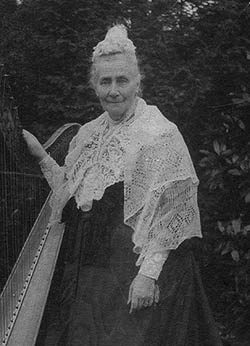Harriet PHELPS 1828 - 1925
Fifth child of Joseph Phelps (1791–1876) and Elizabeth DICKINSON (1795–1876)
Born 9th February 1828, Bramblebury, Kent.
Died 25th November 1925, Pinetown, Natal
Married 25 November 1854 in Funchal, Madeira to John Lake CROMPTON (1815–1889)
John and Harriet had ten children:
Theodore (1855–1867)
Eustace (1857–1933)
Bede (1859– 1934)
Beatrice (1861–1944)
Mary (1864–1948)
Agnes (1866–1930)
Harriet (1868–1904)
Cecilia (1870–1919)
Katherine (1871–1877)
Godfrey (1873–1950)
Harriet
Harriet spent her childhood in Madeira. She was often in charge of the education of her younger siblings, though she, like her sisters, had received her own education from her mother and visiting tutors.
After a bout of illness in 1850, she spent some months in England and on her return met John Lake Crompton, an English clergyman who had come to Madeira for his health and had already enjoyed the hospitality of the Phelps family. They were married in Funchal with a civil ceremony at the British Consulate, followed by a Church wedding. She was 26 and he 39.
Harriet and John's first child was born in Funchal but they soon began to look for a Protestant colony with a warmer climate. After six months in England, they sailed for Natal on 1st December 1856, arriving at Durban on March 1st 1857 in the good ship Admiral (Capt. Glendenning) following an adventurous voyage: a serious mutiny breaking out which was quelled through the good offices of John.
After a sojourn of a month of two at Durban with Canon Mackenzie, afterwards Missionary Bishop to Central Africa, and a few ox-wagon travels, they settled at Pinetown at the then local hostelry known as Fort Funk, owned by the late A. K. Murray. John later purchased this and renamed it Breightmet, after an estate of the Crompton family in Lancashire. Harriet resided there for the rest of her life, surrounded with an old-world garden containing many and rare plants from divers climes. She was responsible for introducing many plants from Madeira, which are favourites in Natal gardens today.
Harriet bore three more sons and six daughters and had to learn to manage without trained servants and overcome many hardships attached to life in a distant colony. Her sister Mary visited her in 1865 and, horrified at the primitive conditions, helped to install an improved kitchen. Mary's letters to her sister Bella at this time suggest that John was not only inconsiderate but even abusive towards Harriet. Her brother Arthur also visited them on his way from India to England on leave in 1866 and accompanied John on horseback on some of his land-buying expeditions. (When Harriet's granddaughter, Natalie, bought a piece of land at Umdhloti Beach in 1952 and named it the Carmo, after the family home in Madeira, she found that the original title deed had been granted to John Lake Crompton.)
In 1858 Harriet's mother writes about Harriet's musical ability: "She feels her author's meaning instinctively, so expresses it well. You may suppose how grateful and thankful I am to dear Aunt Grover for bestowing a beautiful new Piano upon her. It was really a sin for her to be without an Instrument, & I could not help feeling very angry with John for allowing her to be so, while he was spending his hundreds upon tracts of land. He is extremely fond of her, & entirely appreciates her music, but there is nothing graceful or engaging in his disposition & he would never think that a gratification to his wife could be a duty."
After the death of her husband in 1889 she was able to make many voyages to England and the Continent with her unmarried daughters Beatrice and Agnes, sometimes visiting Madeira on the way.
The Second Anglo Boer War from 1899 to 1902 was an anxious time for all the family. Harriet's three surviving sons were all involved in various ways, as well as a number of nephews and cousins. Her home was also opened to nieces and nephews from England who were in need of a warmer climate or had come to try their luck in South Africa.
Harriet was a lady of great literary attainments, keeping herself abreast of modern developments. She was a very devout churchwoman of the advanced high church school, an admirer of true art, a musician of no mean order, her instruments being the pianoforte and the harp, and the fortunate possessor of a particularly sweet and sympathetic voice.
She was one of the pioneers of the Women's Movement in South Africa being the first president of the Pinetown Suffrage Society. Her benefactions were many and varied among both white and black.
Harriet died at Breightmet, aged 97, survived by 6 of her children, 18 grandchildren and 4 great grandchildren. She was laid to rest beside her husband who predeceased her some 35 years, and next to her daughter Katherine, in the picturesque little churchyard of St Andrews, Pinetown.
Letters between Harriet and her siblings and children form a large part of A Memoir in Letters by Penelope Forrest, published in 2011.
